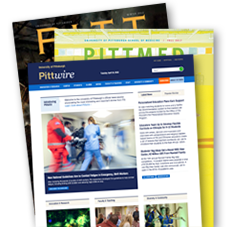Engineering Students Using Such Design Tools as SMART™ Boards Are More Successful at Completing Projects, Pitt Study Finds
PITTSBURGH—Classrooms have become smarter, thanks to the use of digital devices such as computers, SMART™ boards, and other handheld devices. But are these technological advancements birthing a new and smarter generation of engineers? According to a University of Pittsburgh study, yes: Students using such tools are more successful than those who don’t because the technologies promote better working memory and more flexible and transitional thinking.
The study’s findings were published in the April issue of the Journal of Mechanical Design.
“We found that when students hold discussions while using a SMART™ board, for example, as they communicate more clearly through direct referencing, easy writing, or drawing,” said Christian Schunn, a professor of psychology in the Kenneth P. Dietrich School of Arts and Sciences and a research scientist in Pitt’s Learning Research and Development Center. “It not only puts everyone on the same page, but it saves time that otherwise might have been spent on additional explanations or unproductive conflicts resulting from miscommunication.”
To understand the cognitive processes of students in the throes of engineering design processes, Schunn and Jooyoung Jang, lead author and a Pitt PhD student in psychology, set out to study the characteristics of innovation-supporting environments. They collected data across eight semesters, studying 43 interdisciplinary engineering teams consisting of advanced undergraduate and graduate students in biological, industrial, chemical, mechanical, and electrical engineering programs. The teams worked on a single project all semester, with each team being assigned to a different industry-sponsored project.
Early in the process, surveys were distributed to the students with questions related to the students’ prior experiences with engineering design. Group meetings were also video-recorded and analyzed. Lab spaces were equipped with wall-mounted video and audio recording devices that automatically recorded all happenings in the classroom. Each lab space included a meeting table with four chairs, a SMART™ board, and a desktop computer. After collecting the recordings, the researchers labored over several thousands of hours of video to count when each team used the equipment in the space and how often.
The percentage of time each tool was used was analyzed. The teams were then grouped according to levels of success (low, medium, high) in meeting the goals of the project. High- and medium-success groups did not differ statistically in tool use; the main statistical differences were between low-success groups and the other two success levels. Compared to the low-success groups, the high- and medium-success groups used shareable tools like the SMART™ board and prototypes much more frequently, said Schunn.
Additionally, the effectiveness of a tool differed somewhat by the time the tool was incorporated into the design process, as those who used the shareable tools later in the process had extremely unsuccessful designs. The researchers also found that those with engineering experiences outside of a university better used the tools more often.
“There are many underlying mechanisms regarding how these tools support and hinder social and cognitive processes, and these psychological effects should be further explored in greater depth,” said Schunn. “Engineering education may benefit from teaching the importance of shareable tools and early physical prototyping as part of design instruction.”
Funding for this project was provided by the National Science Foundation.
###
5/10/12/mab/lks/jdh
Topics
University Units
Media Resources
Schools of the Health Sciences Media Relations
For more information about Pitt's schools of dental medicine, health and rehabilitation sciences, medicine, nursing, pharmacy, and public health, click here >
To locate stories from health science schools prior to 2013, visit the UPMC news archives »
Urgent Question?
University of Pittsburgh news reps are available to answer urgent media inquiries. Outside of regular business hours (Mon-Fri, 8:30 a.m.-5 p.m.), please email us at media@pitt.edu.
News reps for University of Pittsburgh Health Sciences schools can be reached outside of regular business hours through the paging operator at 1+412-647-2345.


